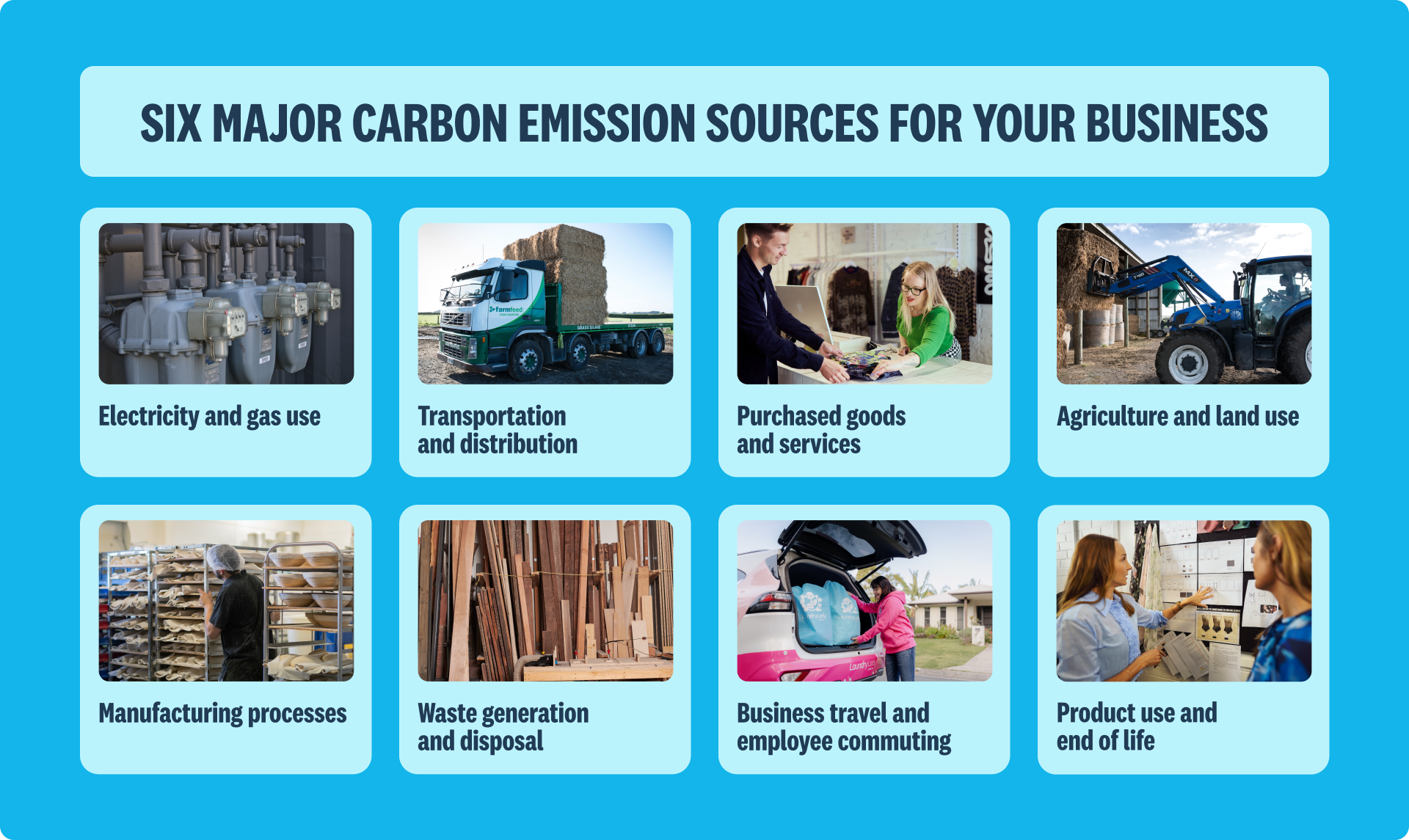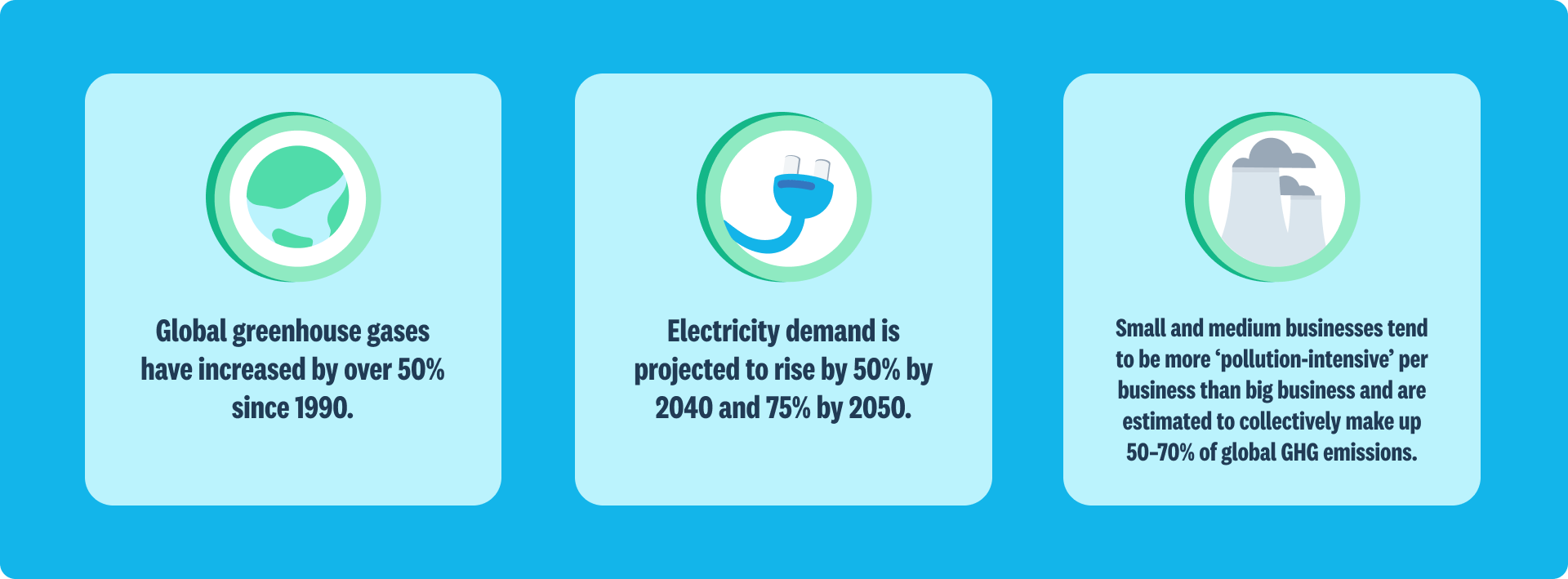Energy and climate
How to reduce your energy use and carbon footprint.

In this topic
What it is
Whether it’s your own electricity and fuel, choices around suppliers, products and freight, or planning for future floods and droughts, energy use and climate change shape how your business runs today and tomorrow.
This guide is all about tackling the greenhouse gases (GHGs) you produce directly and indirectly, especially through energy use, and getting ahead of the risks and costs of climate change. It’s about smarter use of energy, working with forward-thinking suppliers, and planning for a future where climate change and carbon costs matter more than ever.

Why it matters
Climate change is one of the biggest challenges the world faces today; it’s driving extreme weather, threatening resources we depend on, and disrupting communities and economies.
Greenhouse gases like carbon dioxide (CO2), methane and nitrous oxide (N2O) trap heat in the atmosphere and disrupt the earth’s natural climate balance.
Every tonne of carbon saved helps slow the problem, and businesses of all sizes have a part to play. While big emitters grab headlines, small businesses make up most of the global economy – and your choices matter.
Taking action to reduce emissions isn’t just the right thing to do, it’s also a smart move that can save you money, boost efficiency, and build trust with your customers.

Who it matters most for
Some sectors have a much greater climate impact than others, especially those that are large energy users, like in transport, manufacturing, and users of large machinery, or those who emit GHGs directly, such as agriculture, waste management and industrial processes.
Other businesses, from retail to cafes and from medical clinics to offices, generally have smaller footprints but still use energy for lighting, heating, cooling and equipment, so there's still lots of opportunity to be more efficient.
What you can do
Here are some practical and impactful ways you can address energy and climate impacts in your business.
Improve the efficiency of your equipment
One of the most effective places to start is with the equipment that uses up energy. Old or poorly maintained equipment often uses significantly more energy than new, efficient models, anywhere from twice to ten times as much.
Large equipment, machinery, and refrigeration units, such as those used in manufacturing, construction, agriculture, mining, logistics, and even grocery retail can drive up energy use. Maintaining this equipment, optimising its settings, and upgrading out-of-date models can deliver big savings.
Even professional offices can make a difference by choosing efficient computers, printers, servers and other IT hardware, and switching on their power-saving settings.

Source: EnergyStar
Quick actions you can take:
- Upgrade to energy-efficient refrigeration or large machinery
- Switch on power-saving modes for office computers and printers
- Regularly service equipment to maintain performance
Make your building more energy efficient
Lighting, heating and cooling systems typically account for a large share of energy bills. In addition to upgrading to more efficient LED lights and modern HVAC systems, you can reduce the demand for these in the first place through better insulation, natural lighting, and passive heating and cooling. You can also use technology such as motion sensors to ensure lighting is only used when spaces are actually occupied.
These upgrades not only save money but also create more pleasant spaces for your customers and staff.

Source: Energy.gov.au, 2023
Quick actions you can take:
- Install LED lights and optimise natural lighting
- Upgrade to energy-efficient HVAC systems
- Improve insulation in ceilings, walls and windows
- Install sensor-activated lighting
Switch to renewable energy
Burning fossil fuels for electricity is one of the largest sources of GHG emissions, so switching to renewable electricity (that’s generated by solar, wind or sustainable hydropower) is one of the most impactful steps you can take.
Installing solar panels on your own roof is ideal if that is an option for you, since this slashes both your GHG footprint and your energy costs by generating your own energy. Individual solar lights for outdoor spaces can also be an option.
If not, choose to purchase your electricity from a renewable supplier or select a plan backed by 100% renewable sources such as solar or wind farms.

Quick actions you can take:
- Install rooftop solar or solar water heating if possible
- Choose a 100% renewable electricity plan
- Use solar-powered lighting for outdoor areas
Electrify your equipment
Once your electricity is coming from renewable resources, the next step is to switch other fuel-burning equipment to ones that run on that clean electricity, too.
Replacing gas or diesel systems with electric alternatives reduces emissions and lowers running costs, paying you back in the long term. Any business using gas for heating, including manufacturing, kitchens, even hotels and offices, will benefit by swapping for electric models. This can improve air quality, reduce health risks for your staff, and future-proof operations against rising fuel costs.

Source: Climate Council
Quick actions you can take:
- Replace gas space heaters and water heaters with electric versions
- Swap gas stoves and ovens for electric
Reduce transport emissions
Transport burns fossil fuels and is another major source of GHG emissions. Businesses with their own fleets can cut emissions through regular maintenance, choosing low-emissions technology, and transitioning to electric vehicles.
When it comes to moving goods, it's also important to consider consolidating deliveries, better route planning and choosing the right transport mode (for example air vs marine vs road). If you use third-party logistics, be sure to select suppliers who apply these strategies.
Office and people-based businesses should also consider the movements of their staff, especially to and from the client site. Air travel can be especially impactful, so consider replacing in-person visits with virtual meetings where possible.

Quick actions:
- Maintain vehicle fleets, reduce idling, and swap to low-emission vehicles
- Upgrade your fleet to electric vehicles or use e-bikes for local trips
- Plan virtual meetings where possible
Tackle agriculture-specific emissions
Livestock, fertilisers and land-use changes can all contribute significantly to GHG emissions. Strategies like using feed additives, capturing methane for biogas, and applying biochar or agroforestry can cut emissions while boosting productivity. These practices can even be converted into income through carbon credits in some regions.

Source: UN Environment Programme
Quick actions you can take:
- Use feed additives or selective breeding to cut methane
- Capture biogas from animal waste for on-farm energy
- Apply biochar or integrate trees into paddocks (agroforestry)
Build climate resilience
Climate change is no longer a future possibility – it's a current reality. And it impacts businesses in direct ways, from affecting harvests and ability to grow certain crops, to water shortages affecting livestock and industry, to extreme heat affecting events, tourism and construction, to the disruption and damage caused by extreme weather events like storms.
It's important to think through what effects these could have on your business and put contingency plans in place.

Source: Oxera, 2024
Quick actions:
- Identify potential impacts to your business from climate change
- Develop emergency plans for key operations and supply chains
- Upgrade infrastructure to cope with extreme weather events
Did you know: Xero helps you calculate your footprint for free?
We've partnered with Sumday to offer a free 12-month subscription to their tool which connects directly to your Xero account to quickly estimate your emissions based on your financial data.
Get started now
See it in practice
Kiely
Learn how plumbing business Kiely is taking a lead in climate action with the help of Sumday and differentiating itself with customers.
Watch their storyZolo
Learn how e-waste recycling business Zolo used Sumday to quickly understand its own carbon footprint and plan steps to reduce it.
Watch their story
How to know if it’s working
The most common metric for performance in this topic is a carbon footprint, an indicator of the total GHG emissions caused by your business, directly or indirectly.
Your footprint is actually made up of various inputs, including energy use, transportation, purchases of goods and services, waste generated, and chemical processes where relevant. All of these are converted using standard emissions factors into a single figure – a carbon dioxide equivalent (CO2e) – which can then be aggregated into one overall footprint.
To calculate your carbon footprint, you’ll need:
- your electricity, gas and fuel bills
- travel and freight data (for owned and third-party logistics)
- other invoices for things such as waste removal and goods purchased.
Many businesses also set targets to reduce their carbon footprint. This can be a percentage reduction by a certain date, such as 50% reduction by 2030, or a total reduction, such as net zero by 2040. (You can see the definition of this below). In fact, it’s common for businesses to use a combination of both of these targets to reflect their short- and long-term ambitions.
How to learn more
Tools, calculators, guidance and a commitment framework to help small businesses measure and reduce emissions.
SME Climate HubTools, calculators, guidance and a commitment framework to help small businesses measure and reduce emissions.
SME Climate HubPractical energy-saving tips and tools for small commercial buildings.
Energy Star for Small Business (US)Practical energy-saving tips and tools for small commercial buildings.
Energy Star for Small Business (US)Guide to carbon emissions and energy management with an Asian lens.
SME Sustainability Hub (Singapore)Guide to carbon emissions and energy management with an Asian lens.
SME Sustainability Hub (Singapore)Guidance for businesses on energy management, including sector-specific and equipment-specific guides.
Energy.gov.au Business (AU)Guidance for businesses on energy management, including sector-specific and equipment-specific guides.
Energy.gov.au Business (AU)Recommends tailored actions for your business based on seven simple questions supported by simple action guides and case studies.
Climate Action Toolbox (NZ)Recommends tailored actions for your business based on seven simple questions supported by simple action guides and case studies.
Climate Action Toolbox (NZ)In-depth online courses to learn carbon accounting and how it applies to business leaders, procurement professionals and the finance industry.
Sumday AcademyIn-depth online courses to learn carbon accounting and how it applies to business leaders, procurement professionals and the finance industry.
Sumday AcademyThese frequently provide free advice, training, or financial support tailored to local energy markets and regulations.
These frequently provide free advice, training, or financial support tailored to local energy markets and regulations.